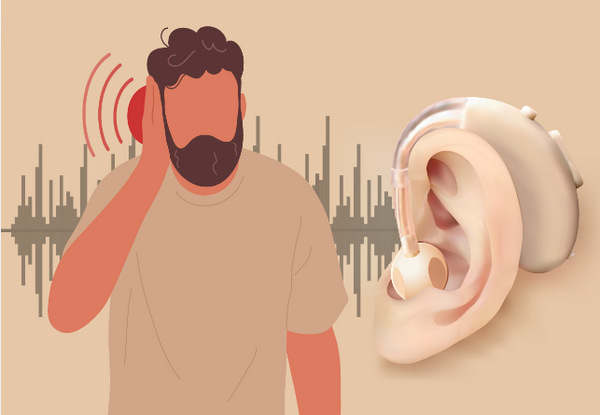Navigating One-Ear Hearing Loss: Causes, Treatments, and Tips

Understanding Hearing Loss in One Ear
Hearing loss in one ear (unilateral hearing loss) significantly impacts sound perception. It can manifest suddenly, partially, or temporarily, often without pain but possibly with ringing. Recognizing symptoms like muffled hearing early is crucial. Varied causes of hearing loss in one ear include infections, noise exposure, or even COVID. Understanding these is key for prevention and treatment. This guide explores symptoms, reasons, and potential hearing loss in one ear treatment options, particularly for sudden hearing loss. We aim to clarify this condition, offering guidance for recovery and adaptation to improve quality of life.
Core Reasons Behind Hearing Loss in One Ear
Understanding the core reasons behind hearing loss in one ear is key to addressing it. This condition can appear suddenly, sometimes overnight due to infections or blockages, or develop gradually and subtly over time. Various medical conditions can lead to unilateral hearing loss, including infections (like those associated with COVID), autoimmune diseases, Ménière’s disease (often accompanied by vertigo and ringing), benign tumors like acoustic neuromas pressing on the auditory nerve, or even a stroke affecting the brain's sound processing centers. External factors are also significant culprits. Exposure to loud noises, whether brief and intense or prolonged, can cause temporary or permanent damage. Physical trauma like head injuries, falls, rapid pressure changes (barotrauma from diving or flying), and simple ear canal blockages from wax or foreign objects can also lead to hearing loss in one ear. Given the wide range of potential causes, symptoms like sudden loss of hearing, painless loss, or persistent ringing in one ear warrant immediate attention from a healthcare professional for accurate diagnosis and timely treatment, which is crucial for better recovery outcomes.
Recognizing the Symptoms and Signs of Hearing Loss in One Ear
Recognizing the signs of hearing loss in one ear is crucial for managing your hearing health. Understanding these subtleties helps you know when professional help is needed.
Identifying the Early Signs
Early signs include ringing in one ear (tinnitus) or temporary hearing loss after loud events. You might also find yourself tilting your head to hear better or struggling with conversations in mono. These are hints to listen to your body.
When to Seek Medical Advice
Seek medical advice promptly for sudden hearing loss in one ear, even with no pain, as it can indicate serious conditions. Also consult a doctor if sounds become muffled or your ear doesn't adjust after pressure changes (like flying).
Discussion on “Sudden Hearing Loss in One Ear No Pain” and Its Implications
Sudden hearing loss with no pain might seem less urgent but warrants immediate medical attention. It can be linked to viral infections, autoimmune diseases, or other serious underlying issues requiring prompt diagnosis and treatment.
Recognizing these symptoms and signs is key to proactive health management. Each sign, whether temporary or persistent, guides you toward taking necessary action for your hearing health.
The Diagnosis Process for Hearing Loss in One Ear
The diagnosis process is essential to understand the causes and implications of hearing loss in one ear, guiding appropriate treatment.
The Role of an MRI in Diagnosing Hearing Loss in One Ear
An MRI can be crucial, especially for sudden hearing loss without an obvious cause. It provides detailed images to identify issues like acoustic neuromas or other structural or neurological problems affecting hearing.
Understanding the Different Tests
Various tests help diagnose hearing loss. Audiometric evaluations measure hearing thresholds across frequencies. Tympanometry assesses middle ear function, and acoustic reflex tests check muscle responses to sound, providing a comprehensive hearing profile.
What a Partial Loss of Hearing in One Ear Reveals About Overall Health
A partial loss of hearing in one ear can signal broader health issues, potentially linked to cardiovascular problems, diabetes, or cognitive decline. Lifestyle factors like noise exposure may also contribute. Painless or ringing loss might suggest infections or autoimmune disorders.
The diagnostic process explores your auditory health thoroughly. Understanding the diagnosis is the first step towards effective treatment and management strategies for hearing loss in one ear.
Treatment Strategies for Unilateral Hearing Loss
Various treatment strategies exist for unilateral hearing loss, offering ways to regain balance in your auditory world.
Temporary vs. Permanent Treatment Options
Temporary hearing loss might be treated with medications (for infection/inflammation) or blockage removal. Permanent hearing loss requires long-term solutions, but effective management options are available.
Innovative Hearing Aids Tailored for Single-Ear Hearing Loss
Modern hearing aids are tailored for hearing loss in one ear. CROS systems route sound from the affected ear to the better one. Many aids offer features like directional microphones and wireless connectivity to devices, enhancing the listening experience.
Exploring Tinnitus and Hearing Loss in One Ear Treatments
Treating concurrent tinnitus and hearing loss in one ear often involves multiple strategies. Sound therapy and tinnitus-masking features in hearing aids can help manage the ringing. Cognitive-behavioral therapy (CBT) addresses the perception of tinnitus. For profound loss with significant tinnitus, cochlear implants might be an option.
Treating unilateral hearing loss often requires a combined approach using technology, therapy, and sometimes medical interventions, tailored to the individual's unique situation.
Living with Hearing Loss in One Ear
Living with hearing loss in one ear requires adjustments, but with the right strategies, you can navigate life effectively and confidently.
Coping Mechanisms and Lifestyle Adjustments
Adopt coping strategies like positioning your good ear towards speakers, minimizing background noise, using assistive listening devices, and utilizing visual cues (lip-reading, body language) to enhance communication.
Is Hearing Loss in One Ear Considered a Disability? – Societal and Medical Perspectives
Medically, hearing loss in one ear can be a disability if it significantly impacts daily activities. Societal perception varies; educating others about the challenges is important for understanding and support.
Support Systems and Resources
You're not alone. Utilize support systems like hearing loss associations, online communities, audiologists, counselors, and disability accommodations. Lean on friends and family for understanding and communication adjustments.
Managing hearing loss in one ear is achievable. Embrace support, use available tools, and remember it's just one part of your journey. With the right approach, you can continue to thrive.
Prevention and Maintenance for Unilateral Hearing Loss
Proactive steps can help prevent unilateral hearing loss and maintain ear health, preserving your ability to enjoy life's sounds.
Preventative Measures for Protecting Against Unilateral Hearing Loss
Protect your ears from loud noise using earplugs or noise-canceling headphones. Take breaks from noise exposure. Schedule regular hearing check-ups with an audiologist to monitor changes early.
Long-term Health Strategies to Maintain Ear Health
Maintain overall health by managing conditions like high blood pressure and diabetes. Eat a balanced diet rich in nutrients beneficial for ear health (e.g., Omega-3s). Exercise regularly to improve blood flow. Be mindful of ototoxic medications and discuss risks with your doctor.
Preventing hearing loss in one ear involves consistent healthy habits, noise protection, and regular medical care. Cherish your hearing and take steps to preserve it.
Conclusion: Navigating the World with Unilateral Hearing Loss
Concluding our exploration, remember that while challenging, navigating life with hearing loss in one ear is achievable with the right knowledge and support.
Recap of Key Points Covered in the Article
We've covered the varied causes (sudden, gradual, infections, injury), crucial symptoms (tinnitus, painless loss), diagnostic processes, effective treatment strategies (hearing aids, tinnitus management), coping mechanisms for living with hearing loss, and essential prevention methods.
Encouragement for Consultation and Proactive Health Measures
Crucially, seek professional consultation if you suspect hearing loss. Be proactive with check-ups and preventative measures. Early action significantly improves outcomes and helps maintain your quality of life.
Final Thoughts on the Importance of Addressing Hearing Loss in One Ear
Addressing hearing loss in one ear is vital as it impacts social, work, and personal life. However, with effective management, technological advancements, and growing awareness, individuals can live fully. Stay hopeful, empowered, and connected.
Discover comprehensive insights into unilateral hearing loss, its causes, symptoms, management strategies, and preventative measures to enhance auditory health.
Discover comprehensive insights into unilateral hearing loss, its causes, symptoms, management strategies, and preventative measures to enhance auditory health.





